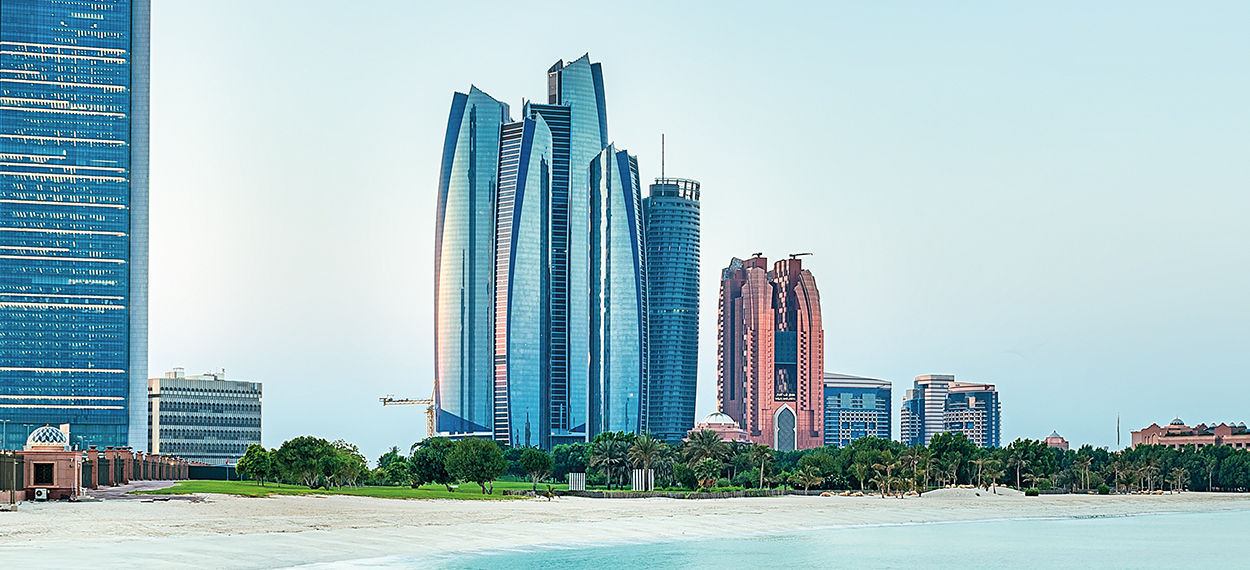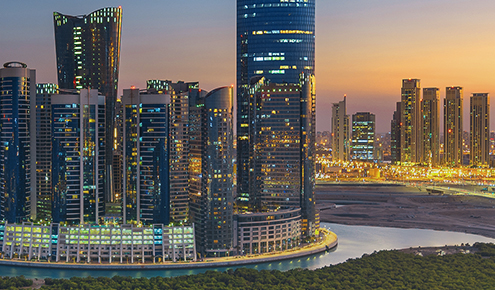Strategic Review Management Discussion & Analysis

Key indicators (FY’20)
Net Profit
(AED bn)
Return on average tangible equity
(ROATE %)1
Return on average assets
(ROAA %)1
Basic earnings per share
(EPS — AED)
Q4’20/FY’20 Financial Highlights2
Note: In March 2020, the purchase price allocation was completed. As required under IFRS3, the fair value of loans and advances, investment securities and non-controlling interests as at the acquisition date were updated from the previous provisional amounts reported. Therefore, the comparative information has been restated to reflect these adjustments.
1 For ROATE/ROAA calculations, net profit attributable to equity shareholders is considered, i.e., net profit after deducting interest expense on Tier 1 capital notes.
2 The results for FY’20 are based on the pro forma financial statements for the combined entity, following the merger between ADCB and Union National Bank, and the subsequent acquisition of Al Hilal Bank on 1 May 2019.
3 Operating expenses include non-recurring expenses pertaining to integration-related costs.
Pro forma comparisons in this section are calculated for the quarter ended 31 December 2020 (‘Q4’20’) versus the quarters ended 30 September 2020 (‘Q3’20’) and 31 December 2019 (‘Q4’19’) unless otherwise specified.
STEADY OPERATING PROFIT, WITH LOWER COST OF FUNDS AND AN IMPROVED COST TO INCOME RATIO CUSHIONING THE IMPACT OF LOW INTEREST RATES AND SUBDUED ECONOMIC ACTIVITY DUE TO COVID-19
FY’20 operating profit before impairment allowances held steady at AED 7.945 billion, compared with AED 7.977 billion in FY’19. Lower operating expenses offset a decline in operating income amidst the challenging global macroeconomic environment. Q4’20 operating profit before impairment allowances of AED 1.990 billion was 5% higher quarter on quarter and down 1% from the previous year. The sequential rise was driven by an improved cost of funds, lower operating expenses and a rise in net fees and commission income.
Net interest income of AED 9.783 billion for FY’20 decreased 6% from FY’19 on account of lower benchmark rates and volumes amid subdued macro-economic conditions. Interest expense improved 48% to AED 4.282 billion in FY’20 on account of a significant improvement in the cost of funds, supported by increased low-cost deposits, reduced reserve requirements and declining benchmark rates. Q4’20 interest expense improved 19% sequentially and 63% over the prior year. Cost of funds decreased by 21 basis points sequentially and 135 basis points year on year to 0.85% in Q4’20.
Net interest margin (NIM) increased sequentially to 2.66% in Q4’20 from 2.59% in Q3’20 on account of lower cost of funds and a rise in net interest income due to fair value adjustments. NIM was 2.77% in FY’20 compared to 2.84% in FY’19.
Non-interest income of AED 701 million in Q4’20 was down 1% from Q3’20 and 20% higher than in Q4’19. The year on year increase was driven by an increase in other operating income to AED 187 million in Q4’20 from AED 74 million in Q4’19, primarily due to a gain on the sale of investment securities. Net fees and commission income continued on an upward trend, rising 16% sequentially, as card-related and loan processing fees increased. Trading income for the quarter increased 1% quarter on quarter and was 25% higher than a year earlier.
Net profit of AED 3.809 billion in FY’20 compared with AED 5.244 billion in FY’19, impacted by impairment charges on NMC Health Group, Finablr and associated companies and macro-economic overlays reflecting the Bank’s prudent approach to provisioning. Q4’20 net profit of AED 1.007 billion decreased 26% sequentially and 4% year on year, primarily on account of higher impairment charges due to a number of corporate accounts. Return on average tangible equity was 8.3% for FY’20 and 9.4% for Q4’20.
SIGNIFICANT DECREASE IN OPERATING EXPENSES, DRIVEN BY STRONG PROGRESS IN CAPTURING MERGER SYNERGIES AND ADDITIONAL COST EFFICIENCY MEASURES
The Bank continued to focus on realising efficiencies across the organisation. Operating expenses were AED 4.526 billion in FY’20, down 14% from the previous year, and AED 1.073 billion in Q4’20, 3% lower quarter on quarter and a decrease of 16% year on year. Cost to income ratio, excluding one-off integration costs, improved 190 basis points year on year to 35.1% in FY’20.
Synergies captured in Q4’20 of AED 275 million, bringing the cumulative total in FY’20 to AED 917 million. Having surpassed its run-rate synergy target of AED 750 million in 2020, the Bank is firmly on track to exceed its AED 1 billion run-rate synergy target in 2021.
Integration costs incurred to date (excluding capex) amount to AED 545 million, well below the budgeted AED 980 million. The Bank recorded integration-related expenses of AED 153 million in FY’20 after reversing AED 74 million of charges in Q4’20.
During 2020, the Bank adjusted its operating model to account for changing customer demand and behaviour due to strong penetration of digital banking services. The branch network was reduced to pre-merger levels of 54 prime locations in the UAE, from 73 branches in Q2’20 and a peak of 127 on merger with UNB in May 2019.4
Greater efficiencies were driven by capture of merger synergies and strong progress on the cost management programme, including in procurement, process optimisation as well as reduction or elimination of discretionary spending.
4 Excluding Al Hilal Bank branches. Al Hilal Bank operates through a network of 13 branches.
MODEST INCREASE IN LOAN BOOK AND RISE IN LOW-COST CURRENT AND SAVINGS ACCOUNT (CASA) DEPOSITS
The Group’s balance sheet remains strong, with total assets standing at AED 411 billion as at 31 December 2020.
Net loans were at AED 239 billion as at end-2020, 4% lower than a year earlier, on account of large corporate repayments at the end of Q2’20, de-risking of the retail loan book and significant provisions. The average loan balance for FY’20 was AED 245 billion.
Total customer deposits were at AED 251 billion as at 31 December 2020, down 4% year to date, as the Bank continued to increase low-cost CASA deposits and to exit high-cost time deposits. CASA balances reached AED 127 billion, an increase of 12 billion sequentially and AED 26 billion during 2020, and accounted for 51% of total customer deposits at the end of 2020, up from 39% a year earlier. The Bank witnessed granular growth in CASA, with retail CASA deposits reporting an increase of AED 15 billion in 2020.
ADCB has participated fully in the UAE Central Bank’s TESS programme to support the UAE economy, offering a package that includes deferment of loan instalments, reduced fees and charges, interest rate reductions and waivers, and rescheduling of working capital facilities for SMEs and corporates. The Bank’s active engagement with customers has resulted in the successful transition of customers out of the deferral scheme. As at 31 December 2020, ADCB had extended a cumulative total of AED 11.018 billion under the TESS programme to support over 67,000 retail and corporate customers. Repayments of AED 4.819 billion have resulted in outstanding deferrals reducing to AED 6.199 billion as at 31 December 2020.
PRUDENT APPROACH TO RISK MANAGEMENT, WITH PROVISIONING REFLECTING CHALLENGING MACRO-ECONOMIC ENVIRONMENT AND CONSERVATIVE ASSESSMENT OF POTENTIAL RECOVERIES RELATED TO NMC HEALTH GROUP
Net impairment charges on loans and advances were AED 3.993 billion for FY’20 and AED 938 million in Q4’20, reflecting the challenging operating environment. In FY’20, the Bank recorded significant provisions and interest in suspense (AED 1.656 billion) on NMC Health Group, Finablr and associated companies. ADCB continues to work closely with the joint administrators and other creditors on a restructuring plan that seeks to preserve and build value at NMC Health Group.
The Bank is comfortable with provisioning levels on NMC Health Group given the positive developments in the company’s recent financial performance and its ongoing restructuring process. NMC Health Group adopted a three-year business plan under the auspices of ADGM-regulated administration and its financial performance improved significantly in H2’20. ADCB, together with a syndicate of lenders, participated in a USD 325 million Administration Funding Facility (AFF) to ensure operational continuity of the NMC Health Group and to pave the way for restructuring. Participation in the AFF has placed the Bank in a strong position to maximise recoveries.
5 Includes fair value adjustments on loans and advances of AED 3.2 billion in Dec’19 and AED 3.9 billion in Dec’20 (for stage 1 and stage 2 accounts only) for computing the coverage ratio.
CONTINUED IMPROVEMENT IN CAPITAL RATIOS AND COMFORTABLE LIQUIDITY POSITION
Total shareholders’ equity was at AED 57 billion as at 31 December 2020.
The Bank remains well capitalised with a Basel III capital adequacy ratio (CAR) of 17.22% and a common equity Tier 1 (CET1) ratio of 13.91% as at 31 December 2020, up from 16.30% and 12.93% respectively at the end of December 2019.
ADCB continues to maintain a comfortable liquidity position, with a liquidity coverage ratio of 156.8%. The Bank maintained a net lending position of AED 20 billion6 in the interbank markets in Q4’20 and had a liquidity ratio of 31.2% as at 31 December 2020.
As part of the TESS programme to respond to Covid-19, the Central Bank of the UAE has allowed banks to tap into their Capital Conservation Buffer (CCB) up to a maximum of 60% and D-SIB buffer up to 100% without supervisory consequences.
6 Excludes loans to banks of AED 11 billion from deposits and balances due from banks, net; but includes AED 228 million of certificate of deposits with central banks and AED 17 billion overnight placement with the Central Bank.

